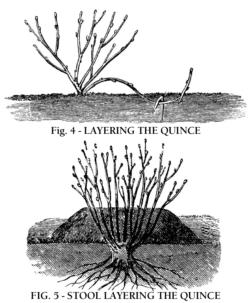Quince Propagation
Where quince seedlings are desired, the quince seed is extracted from mature fruit, cleaned, stratified in sand and stored in a cool place until planting out in late winter - early spring. If the seedlings grow well, they will be large enough to bud with the desired varieties during the following late summer–autumn. Trees on seedling rootstock should produce some fruit by about the fifth year (Campbell 2001).
Asexual Propagation
Multiple plantlets are grown from shoot tissue taken from a single plant, resulting in identical clones. This method is preferred for rootstock development. Traditional methods below.
Mound Layering

Hardwood Cuttings
Quince roots easily by hardwood cuttings from one-year-old wood. The cuttings, about 25 cm (9.8 in), are taken during the late autumn–early winter. This is a common method of propagation, however, the resultant trees tend to produce suckers, which require removal. Cuttings from two- to three-year-old wood also root easily. After one season, cuttings can usually be transplanted to their permanent location (Campbell 2001).

